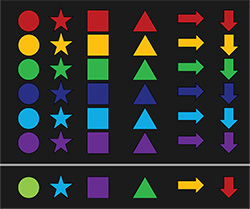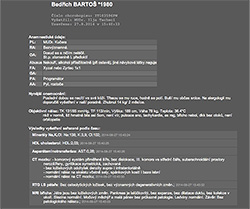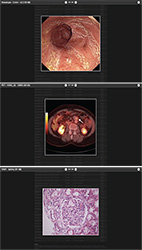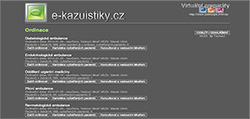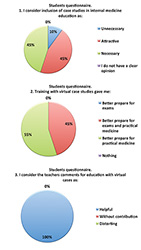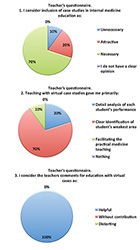
MEFANET Journal 2015; 3(1): 21-27
ORIGINAL ARTICLE
Virtual cases in internal medicine education
Ilja Tachecí1*, Aleš Ryška2
1 2nd Department of Internal Medicine – Gastroenterology, University Hospital Hradec Králové and Faculty of Medicine in Hradec Králové, Charles University in Prague, Hradec Králové, Czech Republic
2 Fingerland Department of Pathology, University Hospital Hradec Králové and Faculty of Medicine in Hradec Králové, Charles University in Prague, Hradec Králové, Czech Republic
* Corresponding author: tacheci@gmail.com
Abstract
Article history:
Received 14 June 2015
Revised 11 August 2015
Accepted 11 August 2015
Available online 26 August 2015
Peer review:
Petr Štourač, Tomáš Kulhánek
Download PDF
Virtual patients represent a useful tool in teaching students clinical reasoning skills. Virtual Cases (www.e-kazuistiky.cz) represent a newly developed interactive problem-based learning system, drawing information from virtual clinics, covering different fields of internal medicine, generating sets of unique virtual patients according to user-predefined program settings (spectrum of diagnoses, number of patients and criteria for passing the course). Basic clinical information including personal data, medical history, symptoms, laboratory values, etc. is generated for each virtual patient. The main task for the student is to determine the optimal diagnostic algorithm (choose adequate diagnostic steps in the correct order), and to determine the correct diagnosis in each virtual patient. Results of diagnostics tests and clinical findings are presented utilising a multimedia presentation (images, video-sequences, audio-recordings). Evaluation of students includes not only assessment of correctly determined diagnosis, but also the diagnostic pathway, which led the user to the specific diagnosis. Thus, the system enables assessment of appropriateness of each test as well as reasonable sequencing of tests and also financial costs of all examinations.
The program is now routinely used in the undergraduate curriculum at the Medical Faculty in Hradec Králové. User hands-on experience was evaluated through anonymous questionnaires. The most appreciated attribute of the system is the game-like involvement and multimedia-supporting environment (for students) as well as the possibility of a detailed analysis of each student’s performance and clear identification of their weakest areas (for tutors).
The system is a useful tool for undergraduate medical education with positive feedback from both students and teachers. The main advantages are flexibility, potential for further growth and no restrictions regarding particular disease, clinical discipline, diagnostic procedure, etc.
Keywords
MEFANET; gamification of medical education; serious games; virtual cases; problem-based learning; scenario-based learning; students’ attitudes; evaluation; interactive training
Introduction
Undergraduate education in internal medicine is based on two main pillars - theoretical education during lectures and seminars and practical training at the patient’s bedside. Teaching at the bedside remains an essential, integral part of the internal medicine curriculum and plays a crucial role in teaching and assessing clinical reasoning to medical students.
However, due to objective reasons, it may face a series of issues and limitations. The optimal organisation of practical education is focused on presentation of patients, revealing a wide spectrum of both common and rare symptoms, syndromes or diseases and their variants. The spectrum of demonstrated diagnoses is highly influenced by several factors in real educational practice – due to specialization of the given department, limited number of patients who are present at the department during the time of practical training and who agree to be examined by students and by the actual condition of the particular patient. Another important factor influencing the composition of presented cases is the teacher. Some teachers tend to present more often rare diseases or symptoms, with a limited or minimal impact on the future professional life of doctors outside tertiary centres. These teachers frequently underestimate the presentation of common (and thus from a practical point of view more important) cases. Presentation of patients is often limited by the duration of practical classes too. Thus, students are missing the experience regarding development of disease features from initial symptoms down to full manifestation.
Another important issue is the lack of diagnostic algorithm training (chaining of rational investigative methods to maximize the diagnostic yield and minimizing the risk of complications in different clinical situations) and the lack of economic knowledge on the part of students concerning costs of each test or diagnostic method.
A potential solution to all of these limitations in clinical reasoning training is a simulation of clinical scenarios utilising information technologies, including so-called serious games concept. Serious games could be defined here as “games” that are designed to entertain players as they educate, train or change behaviour [1]. Clark Abt first defined this term in the early 1970s for non-digital, math-related games by words [2]: “Games may be played seriously or casually. We are concerned with serious games in the sense that these games have an explicit and carefully thought-out educational purpose and are not intended to be played primarily for amusement. This does not mean that serious games are not, or should not be, entertaining.” The real advancement came with the expansion of computer technology in the last 20 years. In medical education, serious games are developed for non-entertainment purposes and designed primarily for clinical skills development [3]. They offer a good dose of realism together with the entertainment factor of a traditional game. Serious games can be used in medical education in many different ways. One of the most attractive and currently most realistic approaches in the serious games field is the use of so-called “virtual patients” or “virtual case studies”. Virtual patients are computer-based scenarios used in simulation of real-life clinical situations in the context of a computer game [4-11].
Aim
The aim of our project was to develop a dynamic database of virtual patients in an outpatient clinic to supplement teaching of internal medicine within a general medicine study program. We wanted to test this environment subsequently during the internal medicine curriculum at the Charles University Medical Faculty in Hradec Králové.
Our newly developed serious games system was named “Virtual cases”. Taking into account the fact that there is a substantial difference between computer simulation currently available (text plus multimedia) and the actual “patient simulator” (which should meet much higher requirements for audio-visual and tactile interaction between the student and computer simulator and which has not, according to the authors’ knowledge, really been developed so far), we prefer the term “virtual cases” to “virtual patients” as this corresponds better with the technology available. The objective of computer simulation and environment of the program is to show students how to select the optimal diagnostic algorithm and establish diagnosis based on available clinical and laboratory data including a complete medical history and clinical examination results. The goal is thus not to replace the bedside teaching with direct contact with the patient by a computer simulation.
Figure 1. Pseudo-random combinations lead to a higher number of cases available for teaching/learning within the project
Figure 2. Patient history and clinical investigation are presented in the beginning of each case
Figure 3. Results of diagnostic tests and biopsy are presented in a multimedia manner
Figure 4. Student results are presented with a conclusion, economy results, bonus and malus points reached in each concrete case
Figure 5. The set of outpatient clinics respects the main subspecialisations of internal medicine
Figure 6. Student questionnaire
Figure 7. Teacher questionnaire
Methods
The main requirements for the new system were to show clinical cases with as realistic features and real-life clinical data as possible. It was our intention to show a broad spectrum of diagnoses covering both frequent and rare disorders, to minimize the risk of repetition of particular cases, teaching optimal diagnostic algorithms taking into consideration also the economic background of the entire diagnostic procedure, to maximize flexibility of the system and establish a software environment capable of further development and expansion into other clinical disciplines without any restrictions regarding the discipline, type of disease or diagnostic procedure.
The main pedagogical objectives of the project were:
- Simulation of real-life diagnostic problems
- Training in rational use of diagnostic procedures
- Automatic evaluation of students’ knowledge and skills
- Possibility of re-evaluating students’ progress during subsequent analysis of individual cases with the teacher
Virtual Cases were prepared as a web-based tool, because web technologies allow effective work with multimedia content and easy access from any computer. Due to the fact, that this is a device intended for the medical education (containing the anonymized data of real patients), access to the system is limited by the necessity of registration, and the approval of the operator.
Preparation of virtual cases from the author’s point of view
Each virtual case was prepared in a similar way. The system allows the authors to choose the outpatient clinic (specialization), in which a given case generates, and select the correct diagnosis, which the student should select after completing the concrete case. There were 4–5 similar real patients with one concrete diagnosis identified (e.g. peptic duodenal ulcer) and all data was drawn from the hospital information system. Their anonymous medical case histories (segmented into history of present illness, past medical history including childhood diseases, family diseases, social history, regular medications, allergies and obstetric/gynaecological history in females), objective findings at physical examination and results of accompanying tests (such as laboratory, X-ray, computed tomography, ultrasound, endoscopic examinations, histological biopsy results, etc.) were put together and copied into the back office form (the same procedure for all virtual cases). Because the students have the possibility to select any diagnostic method or laboratory test presented in the system (not only the pathological one or the methods with a particular relationship to the case study), the authors should define the results for all of them.
The virtual cases generation system
The system was made to generate pseudorandom combinations of the above-mentioned segments (from all patients with the same diagnosis) – e.g. history of present illness from patient A, combined with family history of patient B, results of ultrasound of patient C, etc. (Figure 1). Naturally, it was essential to prevent mismatch of certain parameters (e.g. if a virtual case was a male patient, it is not possible to show chest X-ray results of a female patient, as the breasts visible on the X-ray would not match the clinical data). Mixing and matching individual segments of findings from several different patients prevents repetition of clinical histories and thus the user (student) is always facing a new (although substantially very similar) clinical scenario. With this feature, students are not distracted by their memory when going through repeated cases (such as “…a chemical engineer with symptoms starting on a holiday has a peptic ulcer…”) and must always carefully read all clinical data and not skip any part of the case. The result of this pseudorandom combination is a unique clinical case (personal data, medical history and basic clinical investigation – current clinical picture for each diagnosis) presented to students (Figure 2).
User approach
After reading all initial clinical data (history, objective findings, complaints by the patient, etc.), students are requested to choose what tests should be performed. This is done in steps; therefore after seeing results of one test, the student may decide what the next examination will be. An extensive multimedia database enables presenting clinical findings and results of diagnostics in a fully multimedia manner – as text, photographs, videos, virtual histological slides, etc. (Figure 3). Examination results are realistic (we are using the real patients data) and present in addition to their benefits the common limitations of selected tests too (false positive and negative findings, poor quality of examinations, etc.).
Thus, students are expected to choose a diagnostic algorithm. After they gather sufficient data, they proceed with diagnosis. If the diagnosis is based on sufficient input information (the student is not just guessing, but the diagnosis is really evidence-based) and the suggested diagnosis is correct, the case is successfully completed.
Students evaluation system (bonus and malus points, cost and diagnostic methods sequence evaluation)
The unique multi-level system of evaluation of each student is based on scoring each individual step and their sequence in the diagnostic algorithm (Figure 4).
If the tests selected are beneficial for the diagnosis in a given situation, the student receives positive (so-called “bonus”) points. If the investigation is without contribution or may even harm the patient, the student receives negative (so-called “malus”) points. The optimal (minimal) level of “bonus” points (that must be made before it is possible to establish a definite diagnosis) is determined for each diagnosis by authors (otherwise the conclusion is considered speculative and not supported by a sufficient number of diagnostic tests performed). The maximum level of “malus” points is set for each diagnosis too; the solution of the case is considered unsuccessful and the case is terminated immediately after reaching the maximum malus points level.
A very important part of Virtual Cases is also the effort to show students the diagnostic process economic background. The actual current cost of each test method is included in the system and users have information about the selected diagnostic algorithm costs at every moment. After the maximum cost (determined by the author of the virtual case) is exceeded, the student’s attempt is also considered unsuccessful and solution of the virtual case is terminated.
Because students can choose any diagnostic test available without any up-front limitation, it is essential that the system evaluate if the selected test contributes to reaching the final correct diagnosis. An additional key feature of the system is the original evaluation tool allowing assessment of optimal /acceptable /incorrect sequence of selected diagnostic methods.
Virtual cases were newly created in collaboration with teachers of clinical and preclinical disciplines, programmers experienced in clinical medicine and undergraduate medical students who tested the system. Thus, this multidisciplinary team of authors ensures a balance between the (often differing) expectations of teachers, physicians of clinical and preclinical disciplines, programmers and students regarding the ideal educational tool. The programme was used within the undergraduate curriculum at the Medical Faculty in Hradec Králové. The user (student and teacher) hands-on experience was evaluated in several anonymous questionnaires focused on different aspects of the project. Main topics covered in the questionnaires are: user ratings of virtual case studies, evaluation of case studies contribution from the perspective of teachers and students and evaluation of the teachers contribution to courses using virtual case studies.
Results and discussion
The team of authors created a basic set of 62 case studies covering the major specializations of internal medicine (gastroenterology, hepatology, cardiology, endocrinology, hematology, diabetology, rheumatology, acute medicine and pulmonary medicine, as well as paediatrics) – Figure 5.
After the first 20 virtual cases have been published and tested, the system was put to use in the 4th year of undergraduate medical curriculum (internal medicine) at the Medical Faculty of Charles University in Hradec Králové. The quality and user-friendliness of the project as well as hands-on experience were evaluated through anonymous questionnaires completed by teachers and students, resulting in mostly positive feedback (Figures 6 and 7). The most appreciated attribute of the system from the students’ perspective is the game-like involvement and multimedia-supporting environment; from the teachers’ perspective, it is the possibility of detailed analysis of each student’s performance and clear identification of the weakest areas of the tuition system. Teachers can objectively evaluate students’ knowledge, their diagnostic approach and the strengths and weaknesses leading to the success or failure of each individual student. Each case solved by students is subsequently discussed at the seminar, where each student has to defend the algorithm of selected tests in front of his fellow students and the tutor, explain what they expected from each individual method and why they selected the particular diagnosis. The teacher explains what the other options were, how the approach could have been more straightforward and effective. Thus, each case does not represent only a benefit for the individual student, but for the entire learning group.
In the next phase of the project, additional 42 cases were added to broaden the spectrum of diagnoses. The system was enhanced by newly developed interactive authors’ form, enabling a much easier input of new patients into the system without the need for detailed knowledge of the back-office system. It is expected that this form will help further increase the number of authors who will be willing to contribute with new clinical cases. One additional feature of the virtual cases is also a close link to the system of virtual microscopic slides, which are used in teaching histopathology in the 3rd year of the same medical curriculum. This has been proven over many years as an extremely useful method and has been a tool highly appreciated by students in preparation for both practical classes as well as for final exams in pathological anatomy (http://www.patologie.info/vip). The link to virtual cases further shows students how the knowledge of preclinical disciplines, such as pathology, may be of use in their further medical studies.
The Virtual Cases project is specific from different points of view. The program is focused on teaching the formation of rational diagnostic algorithms and establishing the correct diagnosis. The main difference from the previously published tools using the virtual patients is the unique multilevel evaluation system of student’s progress [10-11]. The aim of this evaluation is to achieve the maximum possible degree of realism. Automatic scoring of each student's step in the four aspects (1. benefits of the examination for determination of diagnosis – “bonus points”, 2. burden of the patient by selected examination – “malus points”, 3. economic burden of health care provider – the comparison of the price of the chosen algorithm in comparison with the “ideal” algorithm defined by the author of a case study and 4. evaluation of correctness of the diagnostic methods sequence in the chosen algorithm) allows the elimination of speculative conclusions and exclusion of dangerous, burdensome or unnecessary diagnostic methods from the algorithms. The system of virtual cases generation is innovative due to the use of pseudo-random combination of individual parts of the cases with the same diagnosis too. This approach leads to the higher number of virtual cases available, which is important to prevent false correlation, and allows focusing on all clinical data. Another important aspect of Virtual Cases teaching, highly acclaimed by the users, is subsequent discussion of cases under the tutor supervision, allowing to obtain feedback for the whole group of students participating in seminar.
Conclusion
The Virtual Cases is a newly developed educational system using the principles of so-called serious games for the purpose of undergraduate education of internal medicine. The 62 case studies (covering the main specializations of internal medicine) were created and the program has been successfully included into the undergraduate curriculum of internal medicine at the Charles University, Faculty of Medicine in Hradec Králové. Virtual Cases were positively evaluated by all users (teachers and students). After adding new virtual cases, the original idea of having a system, which can fully simulate a spectrum of patients in everyday clinical practice, could be achieved.
Acknowledgements
The project was supported by Operational Programme EU: Education for Competitiveness (Modernizace výuky klinického rozhodování napříč pediatrickými obory lékařských fakult v síti MEFANET) – CZ.1.07/2.2.00/28.0038, and by research grant IGA NT11524-5/2010.
References
1. Stokes B. Video games have changed: time to consider “Serious Games”? Development Education Journal 2005; 11(3): 12.
2. Abt C. Serious games. Viking Press: New York 1970.
3. M. Graafland, J. M. Schraagen, M. P. Schijven. Systematic review of serious games for medical education and surgical skills training. Br J Surg 2012; 99 (10): 1322-1330.
4. Berman N, Fall LH, Smith S, Levine DA, Maloney CG, Potts M, Siegel B, Foster-Johnson L. Integration strategies for using virtual patients in clinical clerkships. Acad Med 2009; 84(7): 942-949.
5. Huang G, Reynolds R, Candler C. Virtual patient simulation at US and Canadian medical schools. Acad Med 2007; 82(5):446-451.
6. Ellaway R, Poulton T, Fors U, McGee JB, Albright S. Building a virtual patient commons. Med Teach 2008; 30(2): 170-174.
7. Ellaway R, Topps D, Lee S, Armson H. Virtual patient activity patterns for clinical learning. Clin Teach 2015; 12(4): 267-271.
8. Kononowicz AA, Zary N, Edelbring S, Corral J, Hege I. Virtual patients – what are we talking about? A framework to classify the meanings of the term in healthcare education. BMC Med Educ 2015, 15: 11.
9. Bloice MD, Simonic KM, Holzinger A. Casebook: a virtual patient iPad application for teaching decision-making through the use of electronic health records. BMC Med Inform Decis Mak 2014; 14: 66.
10. Salminen H, Zary N, Björklund K, Toth-Pal E, Leanderson Ch. Virtual patients in primary care: developing a reusable model that fosters reflective practice and clinical reasoning. J Med Internet Res 2014; 16(1): e3.
11. Štourač P, Harazim H, Schwarz D, Křikava I, Komenda M, Štoudek R, Smékalová O, Kosinová M, Hůlek R, Maláska J, Šustr R, Šnábl I, Dušek L, Gál R. Akutne.cz algorithms and sepsis-q scenarios as interactive tools for problem based learning sessions in medical education. Mefanet J 2013; 1(2): 61-73.
Please cite as:
Tachecí I, Ryška A. Virtual cases in internal medicine education. MEFANET Journal 2015; 3(1): 21-27. Available at WWW: http://mj.mefanet.cz/mj-20150614.
This is an open-access article distributed under the terms of the Creative Commons Attribution-NonCommercial-ShareAlike 3.0 License (http://creativecommons.org/licenses/by-nc-sa/3.0/), which permits unrestricted use, distribution, and reproduction in any medium, provided the original work, first published in the MEFANET Journal, is properly cited. The complete bibliographic information, a link to the original publication on http://www.mj.mefanet.cz/, as well as this copyright and license information must be included.
